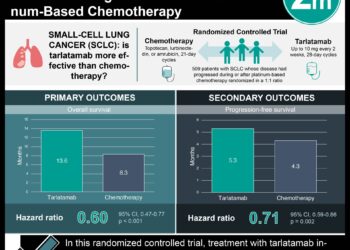Children with viral meningitis likely to be hospitalized, given antibiotics
[tabs tab1=”2MM Rundown” tab2= “2MM Full Report”]
[tab]
Image: PD/Mumps Virus
1. The absolute incidence of pediatric viral meningitis declined from 2005 to 2011, but admission rates remained high.
2. Most children presenting with viral meningitis received parenteral antibiotics (85%) and were admitted for further management (91%).
3. Children under 1 year of age were most likely to undergo an LP for suspected viral meningitis, and older children (>3 years) were most likely to undergo a CT scan in addition to an LP as part of diagnostic testing.
This study evaluates the incidence, diagnosis, and treatment of viral meningitis among the pediatric population. Although this condition is fairly benign, hospitalization rates remain high for these patients. This is likely due to the concern for bacterial meningitis, a severe condition that presents with similar initial symptoms (headache, fever, and irritability) and requires immediate treatment with parenteral antibiotics. Because bacterial cultures may take days to grow, treatment decisions must be made before definitive results are available. The data presented here show that pediatric patients with viral meningitis are overwhelmingly treated with antibiotics and admitted for inpatient management. The cost of these admissions is high, both financially and in terms of resource utilization. Additionally the misuse of antibiotics to treat a viral process poses the public health concern of increasing bacterial resistance. Overall, although the data presented here may be limited due to their heavy reliance on ICD coding and retrospective nature, the authors suggest that improved guidelines for clinical decision-making are needed in both the pediatric emergency department (ED) and in the outpatient setting to reduce hospitalization and mistreatment of children with viral meningitis.
Click to read the study in Pediatrics
[/tab]
[tab]
Image: PD/Mumps Virus
1. The absolute incidence of pediatric viral meningitis declined from 2005 to 2011, but admission rates remained high.
2. Most children presenting with viral meningitis received parenteral antibiotics (85%) and were admitted for further management (91%).
3. Children under 1 year of age were most likely to undergo an LP for suspected viral meningitis, and older children (>3 years) were most likely to undergo a CT scan in addition to an LP as part of diagnostic testing.
This [cross-sectional] study: evaluated the incidence, admission rates, and treatment of viral meningitis in 41 pediatric tertiary care centers between 2005 and 2011. 130,334 children presenting with meningitic symptoms underwent an LP, and of these, 7,618 children were diagnosed with viral meningitis (0.05% of ED visits). Hospitalization rates declined only slightly from 2005 to 2011 (94% versus 91%), although the absolute incidence of viral meningitis declined significantly, from 0.98 cases per 1000 ED visits to 0.25 cases (p<0.001). Older children (>3 years) were less likely to be hospitalized (83% versus 99% for < 3 years, p<0.001) and to were more likely to have both a CT and LP performed (43% vs 9%, p< 0.001), while younger children (<1 year) were most likely to have only an LP performed (p<0.01). Most (85%) children with viral meningitis received parenteral antibiotics, usually third-generation cephalosporins (95%). Hospitalization cost $5,363 (median), while ED treatment cost $1,371 (p<0.001).
In sum: This study evaluates the incidence, diagnosis, and treatment of viral meningitis among the pediatric population. Although this condition is fairly benign, hospitalization rates remain high for these patients. This is likely due to the concern for bacterial meningitis, a severe condition that presents with similar initial symptoms (headache, fever, and irritability) and requires immediate treatment with parenteral antibiotics. Because bacterial cultures may take days to grow, treatment decisions must be made before definitive results are available. The data presented here show that pediatric patients with viral meningitis are overwhelmingly treated with antibiotics and admitted for inpatient management. The cost of these admissions is high, both financially and in terms of resource utilization. Additionally the misuse of antibiotics to treat a viral process poses the public health concern of increasing bacterial resistance. Overall, although the data presented here may be limited due to their heavy reliance on ICD coding and retrospective nature, the authors suggest that improved guidelines for clinical decision-making are needed in both the pediatric emergency department (ED) and in the outpatient setting to reduce hospitalization and mistreatment of children with viral meningitis.
Click to read the study in Pediatrics
By Emilia Hermann and Devika Bhushan
More from this author: AAP urges bottle feeding over breastfeeding in mothers with HIV, Pediatric influenza burden remains high despite new vaccination recommendations, Community hospitals rely on greater CT use to diagnose pediatric appendicitis, Cow’s milk consumption linked to increased vitamin D and decreased iron stores in early childhood, Delayed growth seen in children with congenital heart disease, No association found between maternal NSAID use and newborn pulmonary hypertension
© 2013 2minutemedicine.com. All rights reserved. No works may be reproduced without written consent from 2minutemedicine.com. Disclaimer: We present factual information directly from peer reviewed medical journals. No post should be construed as medical advice and is not intended as such by the authors or by 2minutemedicine.com. PLEASE SEE A HEALTHCARE PROVIDER IN YOUR AREA IF YOU SEEK MEDICAL ADVICE OF ANY SORT. Content is produced in accordance with fair use copyrights solely and strictly for the purpose of teaching, news and criticism. No benefit, monetary or otherwise, is realized by any participants or the owner of this domain.
[/tab]
[/tabs]






